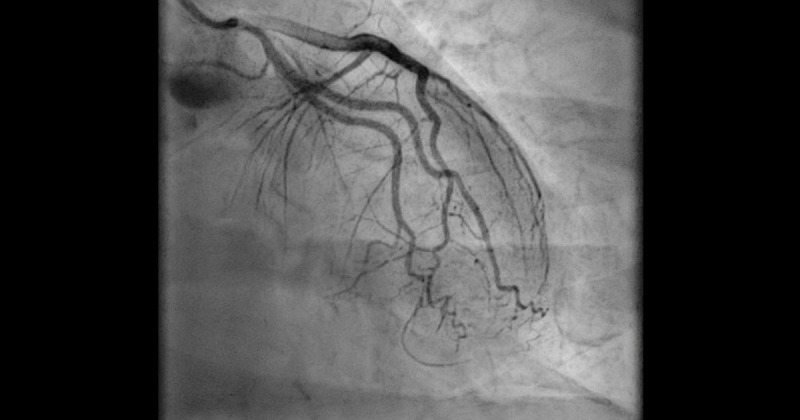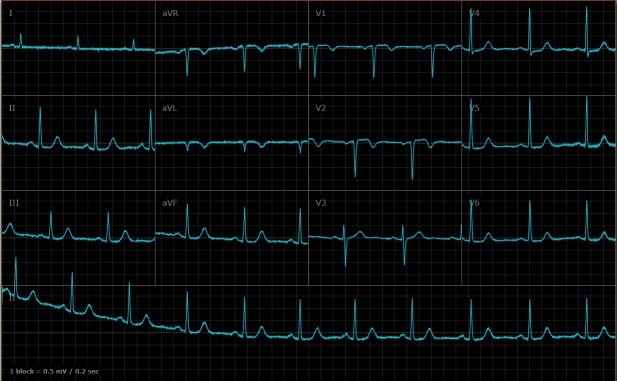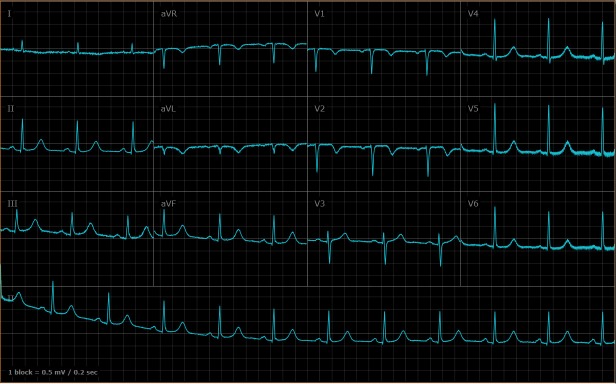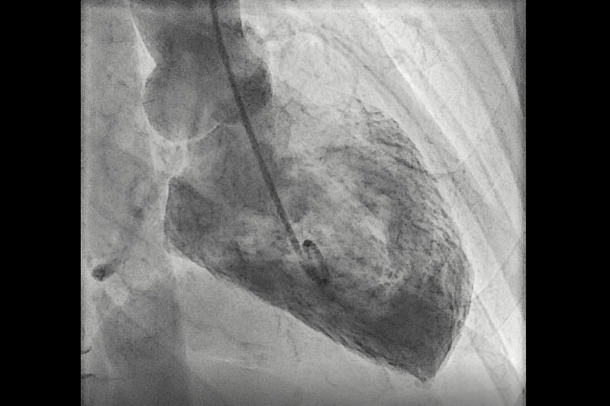Abstract
Takotsubo cardiomyopathy is a left ventricular dysfunction that typically occurs after sudden intense emotional or physical stress and mimics myocardial infarction. We describe a case of a 60-year-old woman that presented to the emergency department with chest pain after she attended a wedding and ate a large amount of wasabi, assuming it to be an avocado. To the best of our knowledge, this is the first report of takotsubo cardiomyopathy triggered by wasabi consumption.
Keywords: cardiovascular medicine, interventional cardiology
Background
Takotsubo cardiomyopathy, also known as ‘broken heart syndrome’, is a left ventricular dysfunction that typically occurs in older women after sudden intense emotional or physical stress. The left ventricle shows global dilation with basal contraction, forming the shape of the narrow-necked jar, used in Japan to trap octopuses (takotsubo).1 This syndrome mimics myocardial infarction as patients present with chest pain, elevated cardiac enzymes and ST segment elevation or T-wave inversion on their ECG. Most patients with takotsubo have normal coronary arteries, but it should be emphasised that incidentally found coronary artery disease does not exclude the diagnosis of takotsubo, according to the modified Mayo Clinic Diagnostic Criteria.2 Patients who survive the acute episode typically recover systolic ventricular function within about 6 weeks.3 However, although takotsubo cardiomyopathy is considered a benign condition, serious cardiac complications can occur including pulmonary oedema, arrhythmias, left ventricular thrombus and cardiogenic shock.4
Case presentation
We describe a case of a 60-year-old woman that presented to the emergency department with chest pain after she attended a wedding and ate a large amount of wasabi, assuming it to be an avocado. Few minutes after she ate the wasabi, she felt a sudden pressure in her chest radiating to her arms, which lasted few hours. She decided not to leave the wedding and the pain started to subside. On the following day, she felt weakness and general discomfort, prompting her to seek medical evaluation.
On admission, her blood pressure was 174/95 mm Hg, heart rate was 81 beats per minute (bpm), her saturation was 100% in room air and she was afebrile. No signs of heart failure were noted—she had normal heart sounds, without murmurs, her lungs were clear on auscultation and she had no oedema. A point-of-care ultrasound revealed moderate left ventricular dysfunction. First ECG (figure 1), done immediately in the emergency department, showed normal sinus rhythm, 65 bpm, with significant ST segment elevation in V1-V2, and without any segment prolongation. Second ECG (figure 2), which was done almost 12 hours after admission, showed normal sinus rhythm, 67 bpm, with T-wave inversions in V1-V2 and a prolonged QT segment (QTc=490 ms).
Figure 1.
Normal sinus rhythm, 65 beats per minute, with significant ST segment elevation in V1-V2.
Figure 2.
Normal sinus rhythm, 67 beats per minute, with T-wave inversions in V1-V2 and a prolonged QT segment (QTc=490 ms).
First troponin T was 424 ng/L (normal range 0–14 ng/L). Complete blood count, chemistry and coagulation studies were normal. She responded well to sublingual nitroglycerin spray and was transferred to the catheterisation laboratory.
On angiography, a non-obstructive coronary artery disease was noted (figure 3, video 1), and left ventriculography (figure 4, video 2) showed reduced left ventricular function with akinetic anterobasal, anterior and apical segments and hypokinetic inferoapical and inferobasal segments, consistent with a non-classic takotsubo cardiomyopathy.
Figure 3.

Normal coronary arteries on catheterisation.
Video 1.
Catheterisation video showing normal coronary arteries
Figure 4.
Left ventriculography on catheterisation.
Video 2.
Catheterisation video showing left ventriculography consistent with takotsubo (non-classic type)
Echocardiography that was performed 2 days after admission showed moderate to severe left ventricular systolic dysfunction, with estimated left ventricular ejection fraction of 35%. The right ventricular size and function were normal. No wall motion abnormality was described on the echocardiography.
Outcome and follow-up
Our patient was started on ACE inhibitors, beta blockers and aldosterone antagonists as treatment for severe left systolic dysfunction, and was referred to cardiac rehabilitation centre. Follow-up echocardiography 1 month after the event showed normal left ventricular systolic function, with estimated left ventricular ejection fraction of 60%. The right ventricular size and function were normal. No wall motion abnormality was noted.
Discussion
Many takotsubo triggers are described in the literature, such as physical or emotional stress, neurological disease, pheochromocytoma or drugs.5 The only reports of this syndrome triggered by food described anaphylaxis as the mechanism causing takotsubo,6 which was not present in our case. To the best of our knowledge, this is the first report of takotsubo cardiomyopathy triggered by wasabi consumption.
The pathophysiological mechanism of takotsubo remains unknown. However, the main hypothesis postulates an excess of catecholamines and hyperactivity of the nervous system,2 which may lead to cardiotoxicity in subjects with increased susceptibility of the coronary microcirculation and of cardiac myocytes to the stress hormones.7
It is important to emphasise that many studies demonstrate neuroprotective, anticancer and antioxidant activity of the active ingredient of wasabi.8–10 These studies show this activity is dose-dependent, and use low doses of the active ingredient. In our case report, the amount of wasabi our patient consumed was unusually large, about a size of a teaspoon, which led to stressogenic situation with extreme catecholamine excess.
Learning points.
The mechanism behind takotsubo cardiomyopathy is still a mystery.
The recognition of spicy food causing takotsubo cardiomyopathy not via anaphylaxis adds to the body of literature on takotsubo triggers, and raises the awareness of possible triggers of the disease that were not recognised before.
More research is needed to understand the complicated mechanisms behind this mysterious diagnosis.
Footnotes
Contributors: AF-O and LB conceived of the presented idea, JO and AJ were involved in this patient’s treatment.
Funding: The authors have not declared a specific grant for this research from any funding agency in the public, commercial or not-for-profit sectors.
Competing interests: None declared.
Provenance and peer review: Not commissioned; externally peer reviewed.
Patient consent for publication: Obtained.
References
- 1. Lakdawala NK, Stevenson LW, Loscalzo J, et al. Cardiomyopathy and Myocarditis : Kasper D, Fauci A, Hauser S, Longo D, Larry Jameson J, et al Harrison’s Principles of Internal Medicine, 19e. New York, NY: McGraw-Hill, 2014. http://accessmedicine.mhmedical.com/content.aspx?bookid=1130§ionid=79743046 [Google Scholar]
- 2. Kato K, Lyon AR, Ghadri JR, et al. Takotsubo syndrome: aetiology, presentation and treatment. Heart 2017;103:1461–9. 10.1136/heartjnl-2016-309783 [DOI] [PubMed] [Google Scholar]
- 3. Gupta S, Gupta MM. Takotsubo syndrome. Indian Heart J 2018;70:165–74. 10.1016/j.ihj.2017.09.005 [DOI] [PMC free article] [PubMed] [Google Scholar]
- 4. Kato K, Sakai Y, Ishibashi I, et al. Predictors of in-hospital cardiac complications in patients with Takotsubo syndrome. Heart Vessels 2018;33:1214–9. 10.1007/s00380-018-1172-y [DOI] [PubMed] [Google Scholar]
- 5. Akashi YJ, Goldstein DS, Barbaro G, et al. Takotsubo cardiomyopathy: a new form of acute, reversible heart failure. Circulation 2008;118:2754–62. 10.1161/CIRCULATIONAHA.108.767012 [DOI] [PMC free article] [PubMed] [Google Scholar]
- 6. Yew KL, Kok VS. Exotic food anaphylaxis and the broken heart: sago worm and takotsubo cardiomyopathy. Med J Malaysia 2012;67:540–1. [PubMed] [Google Scholar]
- 7. Ghadri JR, Wittstein IS, Prasad A, et al. International expert consensus document on takotsubo syndrome (Part I): Clinical characteristics, diagnostic criteria, and pathophysiology. Eur Heart J 2018;39:2032–46. 10.1093/eurheartj/ehy076 [DOI] [PMC free article] [PubMed] [Google Scholar]
- 8. Lenzi M, Cocchi V, Malaguti M, et al. 6-(Methylsulfonyl) hexyl isothiocyanate as potential chemopreventive agent: molecular and cellular profile in leukaemia cell lines. Oncotarget 2017;8:111697–714. 10.18632/oncotarget.22902 [DOI] [PMC free article] [PubMed] [Google Scholar]
- 9. Nomura T, Shinoda S, Yamori T, et al. Selective sensitivity to wasabi-derived 6-(methylsulfinyl)hexyl isothiocyanate of human breast cancer and melanoma cell lines studied in vitro. Cancer Detect Prev 2005;29:155–60. 10.1016/j.cdp.2004.07.010 [DOI] [PubMed] [Google Scholar]
- 10. Chen YJ, Huang YC, Tsai TH, et al. Effect of Wasabi Component 6-(Methylsulfinyl)hexyl Isothiocyanate and Derivatives on Human Pancreatic Cancer Cells. Evid Based Complement Alternat Med 2014;2014:1–6. 10.1155/2014/494739 [DOI] [PMC free article] [PubMed] [Google Scholar]





